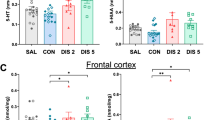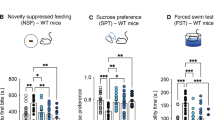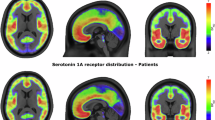Abstract
It has been reported that the 5-HT1A autoreceptor antagonist pindolol can accelerate the antidepressant response to the selective serotonin (5-HT) reuptake inhibitor (SSRI) paroxetine, presumably by preventing the initial decrease in firing activity of 5-HT neurons produced by the SSRI. The present study was aimed at further exploring this treatment strategy in three groups of 10 patients with unipolar major depression allocated sequentially to three treatment arms for 28 days. The administration of the selective 5-HT1A agonist buspirone (20 mg/day for 1 week and 30 mg/day thereafter) with pindolol (2.5 mg TID) was used to activate selectively postsynaptic 5-HT1A receptors. This combination produced a greater than 50% reduction of depressive symptoms in the first week in 8 of 10 patients and the response was sustained for the remainder of the trial. In contrast, the combination of tricyclic antidepressant drugs devoid of effect on the 5-HT reuptake process (desipramine or trimipramine, 75 mg/day for 1 week and 150 mg/day thereafter) with pindolol resulted in only one of ten patients achieving a 50% improvement after 28 days. The combination of the SSRI fluvoxamine (50 mg/day for 1 week and 100 mg/day thereafter) with pindolol produced a marked antidepressant effect but did not act as rapidly as the buspirone plus pindolol combination with none, four, and eight patients achieving a 50% amelioration after 7, 14, and 21 days of treatment, respectively. These results provide further evidence that pindolol may accelerate the antidepressant effect of drugs that alter the function of the 5-HT neurons and that the selective activation of postsynaptic 5-HT1A receptors may induce a rapid and robust antidepressant response.
Similar content being viewed by others
Log in or create a free account to read this content
Gain free access to this article, as well as selected content from this journal and more on nature.com
or
Author information
Authors and Affiliations
Rights and permissions
About this article
Cite this article
Blier, P., Bergeron, R. & de Montigny, C. Selective Activation of Postsynaptic 5-HT1A Receptors Induces Rapid Antidepressant Response. Neuropsychopharmacol 16, 333–338 (1997). https://doi.org/10.1016/S0893-133X(96)00242-4
Received:
Accepted:
Published:
Issue date:
DOI: https://doi.org/10.1016/S0893-133X(96)00242-4
Keywords
This article is cited by
-
Structure-based design of a novel third-generation antipsychotic drug lead with potential antidepressant properties
Nature Neuroscience (2022)
-
Modulation of Monoaminergic Systems by Antidepressants in the Frontal Cortex of Rats After Chronic Mild Stress Exposure
Molecular Neurobiology (2019)
-
Blunted 5-HT1A receptor-mediated responses and antidepressant-like behavior in mice lacking the GABAB1a but not GABAB1b subunit isoforms
Psychopharmacology (2017)
-
Effects of Buspirone on Behavior in Female Mice in a Social Discomfort Model
Neuroscience and Behavioral Physiology (2014)
-
Current Diagnosis and Management of Premature Ejaculation
Current Sexual Health Reports (2014)



